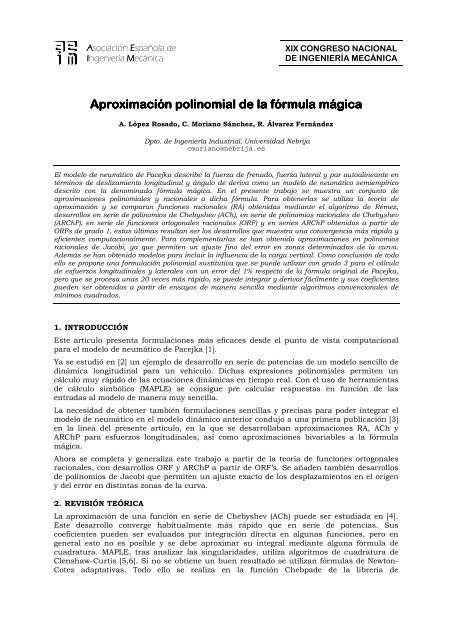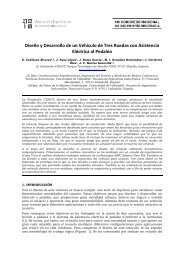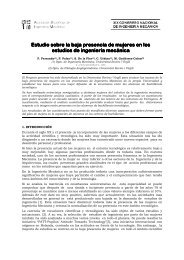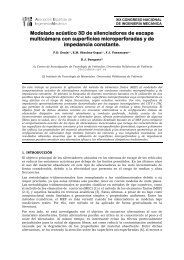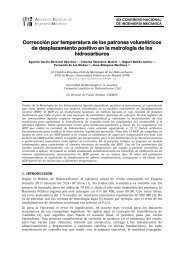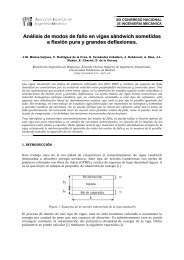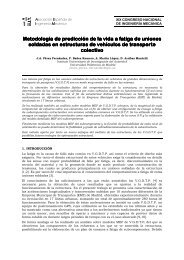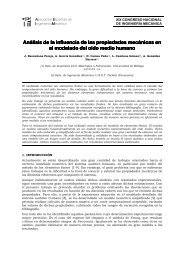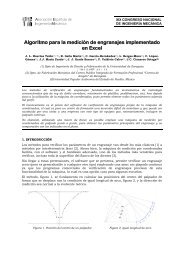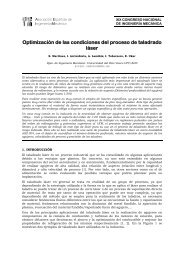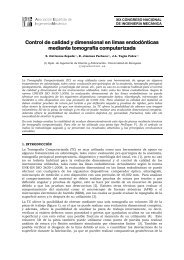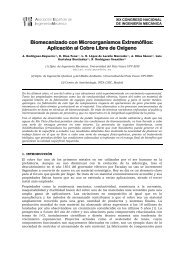18-25 Aproximación polinomial de la fórmula mágica
18-25 Aproximación polinomial de la fórmula mágica
18-25 Aproximación polinomial de la fórmula mágica
You also want an ePaper? Increase the reach of your titles
YUMPU automatically turns print PDFs into web optimized ePapers that Google loves.
Asociación Españo<strong>la</strong> <strong>de</strong><br />
Ingeniería Mecánica<br />
XIX CONGRESO NACIONAL<br />
DE INGENIERÍA MECÁNICA<br />
Aproximación <strong>polinomial</strong> <strong>de</strong> <strong>la</strong> fórmu<strong>la</strong> mágica<br />
A. López Rosado, C. Moriano Sánchez, R. Álvarez Fernán<strong>de</strong>z<br />
Dpto. <strong>de</strong> Ingeniería Industrial. Universidad Nebrija<br />
cmoriano@nebrija.es<br />
El mo<strong>de</strong>lo <strong>de</strong> neumático <strong>de</strong> Pacejka <strong>de</strong>scribe <strong>la</strong> fuerza <strong>de</strong> frenado, fuerza <strong>la</strong>teral y par autoalineante en<br />
términos <strong>de</strong> <strong>de</strong>slizamiento longitudinal y ángulo <strong>de</strong> <strong>de</strong>riva como un mo<strong>de</strong>lo <strong>de</strong> neumático semiempírico<br />
<strong>de</strong>scrito con <strong>la</strong> <strong>de</strong>nominada fórmu<strong>la</strong> mágica. En el presente trabajo se muestra un conjunto <strong>de</strong><br />
aproximaciones <strong>polinomial</strong>es y racionales a dicha fórmu<strong>la</strong>. Para obtener<strong>la</strong>s se utiliza <strong>la</strong> teoría <strong>de</strong><br />
aproximación y se comparan funciones racionales (RA) obtenidas mediante el algoritmo <strong>de</strong> Rémez,<br />
<strong>de</strong>sarrollos en serie <strong>de</strong> polinomios <strong>de</strong> Chebyshev (ACh), en serie <strong>de</strong> polinomios racionales <strong>de</strong> Chebyshev<br />
(ARChP), en serie <strong>de</strong> funciones ortogonales racionales (ORF) y en series ARChP obtenidos a partir <strong>de</strong><br />
ORFs <strong>de</strong> grado 1, estas últimas resultan ser los <strong>de</strong>sarrollos que muestra una convergencia más rápida y<br />
eficientes computacionalmente. Para complementar<strong>la</strong>s se han obtenido aproximaciones en polinomios<br />
racionales <strong>de</strong> Jacobi, ya que permiten un ajuste fino <strong>de</strong>l error en zonas <strong>de</strong>terminadas <strong>de</strong> <strong>la</strong> curva.<br />
A<strong>de</strong>más se han obtenido mo<strong>de</strong>los para incluir <strong>la</strong> influencia <strong>de</strong> <strong>la</strong> carga vertical. Como conclusión <strong>de</strong> todo<br />
ello se propone una formu<strong>la</strong>ción <strong>polinomial</strong> sustitutiva que se pue<strong>de</strong> utilizar con grado 3 para el cálculo<br />
<strong>de</strong> esfuerzos longitudinales y <strong>la</strong>terales con un error <strong>de</strong>l 1% respecto <strong>de</strong> <strong>la</strong> fórmu<strong>la</strong> original <strong>de</strong> Pacejka,<br />
pero que se procesa unas 20 veces más rápido, se pue<strong>de</strong> integrar y <strong>de</strong>rivar fácilmente y sus coeficientes<br />
pue<strong>de</strong>n ser obtenidos a partir <strong>de</strong> ensayos <strong>de</strong> manera sencil<strong>la</strong> mediante algoritmos convencionales <strong>de</strong><br />
mínimos cuadrados.<br />
1. INTRODUCCIÓN<br />
Este artículo presenta formu<strong>la</strong>ciones más eficaces <strong>de</strong>s<strong>de</strong> el punto <strong>de</strong> vista computacional<br />
para el mo<strong>de</strong>lo <strong>de</strong> neumático <strong>de</strong> Pacejka [1].<br />
Ya se estudió en [2] un ejemplo <strong>de</strong> <strong>de</strong>sarrollo en serie <strong>de</strong> potencias <strong>de</strong> un mo<strong>de</strong>lo sencillo <strong>de</strong><br />
dinámica longitudinal para un vehículo. Dichas expresiones <strong>polinomial</strong>es permiten un<br />
cálculo muy rápido <strong>de</strong> <strong>la</strong>s ecuaciones dinámicas en tiempo real. Con el uso <strong>de</strong> herramientas<br />
<strong>de</strong> cálculo simbólico (MAPLE) se consigue pre calcu<strong>la</strong>r respuestas en función <strong>de</strong> <strong>la</strong>s<br />
entradas al mo<strong>de</strong>lo <strong>de</strong> manera muy sencil<strong>la</strong>.<br />
La necesidad <strong>de</strong> obtener también formu<strong>la</strong>ciones sencil<strong>la</strong>s y precisas para po<strong>de</strong>r integrar el<br />
mo<strong>de</strong>lo <strong>de</strong> neumático en el mo<strong>de</strong>lo dinámico anterior condujo a una primera publicación [3]<br />
en <strong>la</strong> línea <strong>de</strong>l presente artículo, en <strong>la</strong> que se <strong>de</strong>sarrol<strong>la</strong>ban aproximaciones RA, ACh y<br />
ARChP para esfuerzos longitudinales, así como aproximaciones bivariables a <strong>la</strong> fórmu<strong>la</strong><br />
mágica.<br />
Ahora se completa y generaliza este trabajo a partir <strong>de</strong> <strong>la</strong> teoría <strong>de</strong> funciones ortogonales<br />
racionales, con <strong>de</strong>sarrollos ORF y ARChP a partir <strong>de</strong> ORF’s. Se aña<strong>de</strong>n también <strong>de</strong>sarrollos<br />
<strong>de</strong> polinomios <strong>de</strong> Jacobi que permiten un ajuste exacto <strong>de</strong> los <strong>de</strong>sp<strong>la</strong>zamientos en el origen<br />
y <strong>de</strong>l error en distintas zonas <strong>de</strong> <strong>la</strong> curva.<br />
2. REVISIÓN TEÓRICA<br />
La aproximación <strong>de</strong> una función en serie <strong>de</strong> Chebyshev (ACh) pue<strong>de</strong> ser estudiada en [4].<br />
Este <strong>de</strong>sarrollo converge habitualmente más rápido que en serie <strong>de</strong> potencias. Sus<br />
coeficientes pue<strong>de</strong>n ser evaluados por integración directa en algunas funciones, pero en<br />
general esto no es posible y se <strong>de</strong>be aproximar su integral mediante alguna fórmu<strong>la</strong> <strong>de</strong><br />
cuadratura. MAPLE, tras analizar <strong>la</strong>s singu<strong>la</strong>rida<strong>de</strong>s, utiliza algoritmos <strong>de</strong> cuadratura <strong>de</strong><br />
Clenshaw-Curtis [5,6]. Si no se obtiene un buen resultado se utilizan fórmu<strong>la</strong>s <strong>de</strong> Newton-<br />
Cotes adaptativas. Todo ello se realiza en <strong>la</strong> función Chebpa<strong>de</strong> <strong>de</strong> <strong>la</strong> librería <strong>de</strong>
A. López et al. XIX Congreso Nacional <strong>de</strong> Ingeniería Mecánica 2<br />
aproximación <strong>de</strong> funciones Numapprox <strong>de</strong> MAPLE. Con <strong>la</strong> librería Orthopoly se pue<strong>de</strong>n<br />
calcu<strong>la</strong>r y manipu<strong>la</strong>r los polinomios <strong>de</strong> Chebyshev.<br />
En caso <strong>de</strong> tener una función que varíe <strong>de</strong> forma rápida en algunas regiones y en otras no<br />
<strong>la</strong>s aproximaciones mediante funciones racionales (RA) son más eficientes; como ocurre en<br />
el comportamiento <strong>de</strong> un neumático, especialmente en esfuerzo longitudinal.<br />
La aproximación <strong>de</strong> Padé permite obtener expresiones racionales con numerador y<br />
<strong>de</strong>nominador <strong>de</strong>sarrol<strong>la</strong>dos en series <strong>de</strong> potencias. Los <strong>de</strong>sarrollos <strong>de</strong> Chebyshev-Padé<br />
permiten obtener expresiones racionales más compactas y exactas. La librería Numapprox<br />
<strong>de</strong> MAPLE también implementa aproximaciones racionales mediante su función Chebpa<strong>de</strong>.<br />
Con ello se obtienen buenas aproximaciones pero no <strong>la</strong>s que presentan mínimo error<br />
máximo (l<strong>la</strong>madas minimax). Para encontrar éstas se utiliza el algoritmo <strong>de</strong> Remez [7], que<br />
parte <strong>de</strong> <strong>la</strong> aproximación <strong>de</strong> Chebyshev-Padé, afina el resultado mediante iteraciones<br />
numéricas y converge a una mejor aproximación minimax.<br />
El algoritmo <strong>de</strong> Remez produce resultados óptimos en <strong>la</strong> aproximación <strong>de</strong> funciones<br />
racionales y <strong>polinomial</strong>es. Permite calcu<strong>la</strong>r el mínimo error <strong>de</strong> cualquier función f(t),<br />
pon<strong>de</strong>rada con algún término <strong>de</strong> peso w(t). La aproximación minimax con polinomios <strong>de</strong><br />
grado n en el numerador y m en el <strong>de</strong>nominador, requiere (n+m) sumas y (n+m)<br />
multiplicaciones para su evaluación y <strong>la</strong> <strong>de</strong>notaremos como aproximación minimax[n,m]. En<br />
[8] po<strong>de</strong>mos ver cualquiera <strong>de</strong> estos métodos.<br />
En MAPLE el algoritmo <strong>de</strong> Remez está implementado mediante <strong>la</strong> función minimax incluida<br />
en <strong>la</strong> librería <strong>de</strong> aproximación <strong>de</strong> funciones Numapprox.<br />
Más recientes trabajos [9,10] muestran <strong>la</strong> idoneidad <strong>de</strong> utilizar <strong>de</strong>sarrollos en serie<br />
polinomios racionales <strong>de</strong> Chebyshev (ARChP). Dichos polinomios heredan <strong>la</strong>s propieda<strong>de</strong>s<br />
<strong>de</strong> los polinomios <strong>de</strong> Chebyshev, también son ortogonales en el intervalo {-1,1}. Sin embargo<br />
al variar nuestras variables in<strong>de</strong>pendientes (<strong>de</strong>slizamiento K y ángulo <strong>de</strong> <strong>de</strong>riva α) entre<br />
{0,100} y {-15º,15º} respectivamente (<strong>de</strong>nominamos genéricamente sus puntos <strong>de</strong> inicio y<br />
final como x in y x fin), no se pue<strong>de</strong> realizar el <strong>de</strong>sarrollo en serie <strong>de</strong> Chebyshev sobre dichas<br />
variables originales, ya que su dominio exce<strong>de</strong> el rango <strong>de</strong> ortogonalidad <strong>de</strong> los polinomios<br />
<strong>de</strong> Chebyshev, luego tendremos que utilizar polinomios en v <strong>de</strong>sp<strong>la</strong>zados [4] mediante un<br />
cambio <strong>de</strong> variable al dominio <strong>de</strong> u que sí varía entre {-1,1}. Se ha realizado por tanto una<br />
doble transformación, <strong>de</strong>l dominio <strong>de</strong> x a v, y <strong>de</strong>l dominio <strong>de</strong> v al <strong>de</strong> u. Se aproxima <strong>la</strong><br />
función en el dominio <strong>de</strong> u mediante <strong>de</strong>sarrollo en serie <strong>de</strong> Chebyshev y sobre esa función<br />
aproximada se <strong>de</strong>shacen <strong>la</strong>s dos transformaciones para obtener <strong>la</strong> función aproximada en el<br />
dominio inicial <strong>de</strong> <strong>la</strong> variable in<strong>de</strong>pendiente.<br />
3. Funciones ortogonales racionales (ORF)<br />
Siguiendo a Bultheel [11], si A={α 1,α 2…} es una secuencia <strong>de</strong> números reales diferentes <strong>de</strong><br />
cero, el espacio vectorial lineal <strong>de</strong> funciones racionales <strong>de</strong> grado n, con polos en {α 1,…,α n} se<br />
<strong>de</strong>fine mediante el espacio <strong>de</strong> funciones L={b 0,b 1…b n}, don<strong>de</strong> <strong>la</strong>s funciones <strong>de</strong> base vienen<br />
<strong>de</strong>finidas por:<br />
1<br />
b<br />
k<br />
(x) = x.(1 − x.αk<br />
).bk− 1(x),<br />
b0<br />
(x) = 1; αk<br />
=<br />
(1)<br />
α<br />
Si ortonormalizamos y asumimos un intervalo en <strong>la</strong> recta real, fuera <strong>de</strong>l cual se encuentran<br />
todos los polos, entonces esas funciones satisfacen <strong>la</strong> re<strong>la</strong>ción <strong>de</strong> recurrencia:<br />
E<br />
n<br />
(1 − xαn−2<br />
)<br />
( E x(1 − xα ) + F (1 − xα )(1 − xα )) ϕ (x) −<br />
(x)<br />
ϕ<br />
n<br />
(x) =<br />
n<br />
n n n−1<br />
n n−1<br />
ϕ<br />
n−2<br />
(2)<br />
E (1 − xα )<br />
Van Deun [12] obtiene los coeficientes <strong>de</strong> <strong>la</strong> re<strong>la</strong>ción <strong>de</strong> recurrencia (E n, F n) para el caso <strong>de</strong><br />
funciones ORF <strong>de</strong> Chebyshev, que son <strong>la</strong>s que tienen funciones <strong>de</strong> peso <strong>de</strong> Chebyshev. Se<br />
n−1<br />
k<br />
n
Aproximación <strong>polinomial</strong> <strong>de</strong> <strong>la</strong> fórmu<strong>la</strong> mágica 3<br />
<strong>de</strong>nomina función <strong>de</strong> peso <strong>de</strong> Chebyshev a una función <strong>de</strong> peso <strong>de</strong> Jacobi con valores <strong>de</strong><br />
δ=±1/2 y γ=±1/2.<br />
Al introducir <strong>la</strong> transformación <strong>de</strong> Joukowski, Van Deun obtiene los coeficientes:<br />
F<br />
n<br />
= −<br />
E<br />
n<br />
1 − β<br />
1 − β<br />
= 2<br />
2<br />
n<br />
2<br />
n−1<br />
(1 − β<br />
(1 − β<br />
2<br />
n−1<br />
(1 + β<br />
2<br />
n−1<br />
)(β<br />
)(1−<br />
β<br />
n<br />
2<br />
n−1<br />
+ β<br />
(1 + β<br />
2<br />
n<br />
)(1 − β<br />
)(1 + β<br />
n−2<br />
2<br />
n<br />
2<br />
n<br />
)(1−<br />
β<br />
)<br />
n−1<br />
) + 2β<br />
β<br />
β<br />
n−1<br />
n<br />
)<br />
(1 − β<br />
)<br />
n−1<br />
n−2<br />
n<br />
β<br />
n−2<br />
)<br />
(3)<br />
4. Desarrollo en serie <strong>de</strong> ORF’s<br />
La mejor aproximación, bajo el criterio <strong>de</strong> mínimos cuadrados, que se obtiene al truncar el<br />
<strong>de</strong>sarrollo en serie <strong>de</strong> funciones ortogonales F(x) (<strong>de</strong> cualquier tipo), <strong>de</strong> una función f(x) se<br />
pue<strong>de</strong> estudiar en [13], toma <strong>la</strong> forma siguiente:<br />
∞<br />
∑<br />
f(x) = ' a F (x)<br />
(4)<br />
j=<br />
0<br />
La comil<strong>la</strong> indica que el primer término está dividido por 2. Los coeficientes toman el valor:<br />
j<br />
j<br />
a<br />
j<br />
1<br />
=<br />
r<br />
r<br />
j<br />
=<br />
j<br />
x<br />
x<br />
2<br />
∫<br />
x<br />
2<br />
∫<br />
x<br />
1<br />
1<br />
w(x).f(x).F (x)dx<br />
w(x).<br />
[ F (x)]<br />
j<br />
j<br />
2<br />
dx<br />
(5)<br />
En este caso particu<strong>la</strong>r <strong>la</strong>s F j(x) son ORF. El valor <strong>de</strong> r j representa <strong>la</strong> norma <strong>de</strong> <strong>la</strong> función<br />
ORF y para funciones ORF con función <strong>de</strong> peso <strong>de</strong> Chebyshev toma valor constante r j = π.<br />
MAPLE no soporta ninguna función re<strong>la</strong>cionada con ORF’s, ni para su generación ni para el<br />
<strong>de</strong>sarrollo <strong>de</strong> funciones.<br />
Dentro <strong>de</strong> <strong>la</strong>s familias <strong>de</strong> polinomios ortogonales clásicos, generados a partir <strong>de</strong> <strong>la</strong> ecuación<br />
diferencial <strong>de</strong> Sturm-Liouville, <strong>de</strong> <strong>la</strong> que <strong>de</strong>rivan también los polinomios <strong>de</strong> Chebyshev,<br />
consi<strong>de</strong>ramos ahora los polinomios <strong>de</strong> Jacobi [14]. Que vienen contro<strong>la</strong>dos por dos<br />
parámetros (δ y γ) y que permiten elegir <strong>la</strong> zona <strong>de</strong> mejor aproximación en el intervalo <strong>de</strong><br />
ortogonalidad. En <strong>la</strong> práctica, esto es interesante porque permitirá ajustar mejor el error en<br />
una zona u otra <strong>de</strong> <strong>la</strong>s curvas <strong>de</strong> esfuerzo longitudinal, <strong>la</strong>teral o momento autoalineante, en<br />
función <strong>de</strong> <strong>la</strong> aplicación en <strong>la</strong> que utilicemos <strong>la</strong> aproximación, por ejemplo buscando error<br />
más reducido en valores <strong>de</strong> <strong>de</strong>slizamiento cercanos a cero, o bien en valores próximos al<br />
máximo esfuerzo o en el punto <strong>de</strong> <strong>de</strong>slizamiento máximo (100%).<br />
La norma r j en polinomios <strong>de</strong> Jacobi, no es constante, sino que es función también <strong>de</strong> γ, δ y<br />
<strong>de</strong>l grado <strong>de</strong>l polinomio n:<br />
r<br />
j<br />
=<br />
2<br />
δ+<br />
γ+<br />
1<br />
Γ(n + δ + 1) ⋅ Γ(n + γ + 1)<br />
n! ⋅(2<br />
⋅ n + δ + γ + 1) ⋅Γ(n<br />
+ δ + γ + 1)<br />
(6)<br />
También se pue<strong>de</strong>n computar y manipu<strong>la</strong>r los polinomios <strong>de</strong> Jacobi utilizando <strong>la</strong> librería<br />
Orthopoly <strong>de</strong> MAPLE. El <strong>de</strong>sarrollo <strong>de</strong> una función en serie <strong>de</strong> polinomios <strong>de</strong> Jacobi utiliza<br />
<strong>la</strong> misma ecuación 4, pero utilizando ahora <strong>la</strong> función <strong>de</strong> peso <strong>de</strong> Jacobi. En este caso <strong>la</strong>
A. López et al. XIX Congreso Nacional <strong>de</strong> Ingeniería Mecánica 4<br />
integral <strong>de</strong>be programarse en MAPLE. No está disponible una librería para <strong>de</strong>sarrollos <strong>de</strong><br />
funciones en serie <strong>de</strong> Jacobi.<br />
5. Fórmu<strong>la</strong> mágica<br />
El mo<strong>de</strong>lo <strong>de</strong> Bakker, Nyborg and Pacejka es un mo<strong>de</strong>lo semi-empírico <strong>de</strong>l neumático<br />
basado en <strong>la</strong> <strong>de</strong>nominada fórmu<strong>la</strong> mágica.<br />
[ ⋅ arctan( B ⋅ X − E ⋅ [ B ⋅ X − arctan( B ⋅ X)<br />
])]<br />
Y = D ⋅ sin C<br />
(7)<br />
Don<strong>de</strong> <strong>la</strong> forma <strong>de</strong> <strong>la</strong> curva vienen <strong>de</strong>terminadas por los parámetros B, C, D y E.<br />
La ecuación pue<strong>de</strong> calcu<strong>la</strong>r:<br />
• Fuerza <strong>la</strong>teral en el neumático Fy en función <strong>de</strong>l ángulo <strong>de</strong> <strong>de</strong>slizamiento α (en grados)<br />
• Fuerza <strong>de</strong> frenado Fx como función <strong>de</strong>l <strong>de</strong>slizamiento longitudinal K (en %)<br />
• Momento autoalineante Mz como función <strong>de</strong>l ángulo <strong>de</strong> <strong>de</strong>slizamiento α.<br />
Po<strong>de</strong>mos estudiarlo más a fondo en [1, 15, 16].<br />
6. APROXIMACIONES A LA FÓRMULA MÁGICA<br />
En este trabajo <strong>de</strong> investigación se han realizado los siguientes <strong>de</strong>sarrollos en serie <strong>de</strong> <strong>la</strong><br />
fórmu<strong>la</strong> mágica RA, ACh, ARChP y ARChP <strong>de</strong> funciones ORF. Se ha visto que estos últimos<br />
son los que presentan una convergencia más rápida en <strong>la</strong> serie. Las expansiones <strong>de</strong>l tipo:<br />
∞<br />
s ⎛ x ⎞<br />
f(x) = ∑ 'a<br />
nTn<br />
⎜ ⎟<br />
(8)<br />
n=<br />
0 x + b<br />
Presentan errores muy bajos respecto <strong>de</strong> <strong>la</strong> fórmu<strong>la</strong> original, con grados <strong>de</strong> polinomios bajos<br />
(n=3). b es una constante para cada neumático y tipo <strong>de</strong> esfuerzo. Se obtiene entonces un<br />
ErrorRel
Aproximación <strong>polinomial</strong> <strong>de</strong> <strong>la</strong> fórmu<strong>la</strong> mágica 5<br />
s<br />
siendo : T ( n, v)<br />
= T ( n,(52/<strong>25</strong>) ⋅ v −1)<br />
Y en forma normal <strong>de</strong> Horner: Fxap = −50.61+<br />
( 8506.27 + ( 13491.33 −<strong>18</strong>571.27<br />
⋅ v)<br />
⋅ v) ⋅ v<br />
siendo : v = x/(x + 4) . Veamos <strong>la</strong>s curvas resultantes:<br />
Braking Force (N)<br />
Longitudinal slip %<br />
Figura 1. Fuerza <strong>de</strong> frenada (N) frente a <strong>de</strong>slizamiento longitudinal en serie <strong>de</strong> Chebyshev <strong>de</strong> <strong>la</strong> función<br />
racional x/(x+b), y su error absoluto (N)<br />
Si hacemos <strong>de</strong>sarrollos en x para distintos valores <strong>de</strong> Fz, buscamos el óptimo <strong>de</strong> b en cada<br />
caso y calcu<strong>la</strong>mos <strong>la</strong> regresión <strong>de</strong> b=f(Fz) se pue<strong>de</strong> acelerar algo más <strong>la</strong> convergencia, en el<br />
caso <strong>de</strong>l neumático ejemplo po<strong>de</strong>mos obtener:<br />
• n≥ 3 con b = 5.4629-0.2829.Fz para Fx con<br />
0≤x≤100 y 0≤Fz≤8 kN<br />
Utilizando <strong>la</strong>s expresiones <strong>de</strong> <strong>la</strong>s aproximaciones en serie <strong>de</strong> polinomios racionales <strong>de</strong><br />
Jacobi se pue<strong>de</strong> partir <strong>de</strong> los valores δ=-1/2 y γ=1/2 correspondientes a <strong>la</strong> función <strong>de</strong> peso<br />
<strong>de</strong> Chebyshev (que es un caso particu<strong>la</strong>r <strong>de</strong> Jacobi). A partir <strong>de</strong> ahí el incremento <strong>de</strong> ambos<br />
reduce el error en <strong>la</strong> zona central <strong>de</strong> <strong>la</strong> curva y lo aumenta en los extremos. También se<br />
pue<strong>de</strong> ajustar el error a cero en los extremos, manteniendo fijo uno <strong>de</strong> los dos parámetros y<br />
variando el otro, conservando los valores <strong>de</strong> error máximo prácticamente constantes en el<br />
conjunto <strong>de</strong> <strong>la</strong> curva. Esto nos va a permitir ajustar por ejemplo, el valor <strong>de</strong> los<br />
<strong>de</strong>sp<strong>la</strong>zamientos en el origen a los valores Sv y Sh indicados en [1, 15, 16].<br />
Vemos como ejemplo el mismo neumático anterior con Fz=6kN, en el que se muestra un<br />
ajuste con error nulo en el origen (Sv=Sh=0), obtenido con los valores δ=-1/2 y γ=-0.4685/2.<br />
La aproximación resultante (con b=3.85) es: Fxap = ( 7369.26 + ( 15916.3 − 19867.52 ⋅ v)<br />
v)v<br />
siendo : v = x/(x + 3.85)<br />
(9)<br />
La curva <strong>de</strong> error tiene un aspecto muy simi<strong>la</strong>r a <strong>la</strong> <strong>de</strong> <strong>la</strong> figura 1, también entre ±50N, pero<br />
con error nulo en el origen.<br />
Podríamos ajustar así el error nulo en el final <strong>de</strong> <strong>la</strong> curva o en su máximo si nos interesara.<br />
También se podría ajustar <strong>la</strong> pendiente en el origen (valor BCD en <strong>la</strong> fórmu<strong>la</strong> <strong>de</strong> Pacejka),<br />
hasta su valor exacto o con un error mo<strong>de</strong>rado, manteniendo valores globales <strong>de</strong> error<br />
máximo también <strong>de</strong>l or<strong>de</strong>n <strong>de</strong>l 1%. Por ejemplo, <strong>la</strong> aproximación (δ=-0.16 y γ=-0.68,<br />
b=3.85): Fxap = −62.86<br />
+ ( 7904.7 + ( 14744.57 −19130.3<br />
⋅ v)<br />
v)v<br />
con <strong>la</strong> misma v (ecuación 9).
A. López et al. XIX Congreso Nacional <strong>de</strong> Ingeniería Mecánica 6<br />
Obteniendo por tanto una pendiente en el origen BCDap=2053 frente a BCDoriginal=2076<br />
(Error=1.1 %). Un valor <strong>de</strong> pico aproximado Dap=6135 frente Doriginal=6097 (Error=0.6 %)<br />
Con un error máximo global <strong>de</strong> 67N (Error=1,09 %). En <strong>la</strong>s aproximaciones <strong>de</strong> <strong>la</strong> forma:<br />
Fap = A0( A1 + ( A2 − A3 ⋅ v)<br />
v)v<br />
; siendo : v = x/(x + b)<br />
(10)<br />
A1/b, sería el valor <strong>de</strong> <strong>la</strong> <strong>de</strong>rivada en el origen (BCD)<br />
7. DETERMINACIÓN DE LOS COEFICIENTES A PARTIR DE ENSAYOS<br />
La ecuación 10 anterior es un polinomio, y es fácil obtener los coeficientes A i <strong>de</strong>s<strong>de</strong> ensayos<br />
en banco mediante los algoritmos convencionales <strong>de</strong> mínimos cuadrados. Para ello,<br />
<strong>de</strong>bemos previamente transformar los datos <strong>de</strong>s<strong>de</strong> <strong>la</strong> variable original, por ejemplo<br />
<strong>de</strong>slizamiento, a <strong>la</strong> variable transformada v=x/(x+b). Veamos un ejemplo:<br />
Datos <strong>de</strong> <strong>de</strong>slizamiento (%) (22 valores simu<strong>la</strong>dos): [0, 1, 2, 3, 4, 5, 6, 7, 9, 13, 17, 21, <strong>25</strong>,<br />
31, 37, 43, 49, 58, 68, 78, 88, 100].<br />
Fuerza longitudinal Fx (22 valores simu<strong>la</strong>dos): [-55.6, 1264.3, 2239.6, 2937.4, 3464.3,<br />
3838.4, 3980.0, 4095.6, 4278.3, 4176.5, 41<strong>25</strong>.3, 3915.4, 3824.9, 3686.0, 3492.6, 3446.6,<br />
3357.7, 3213.7, 3199.7, 3031.9, 3043.7, 2878.3].<br />
Valor óptimo <strong>de</strong> b = 4.195.<br />
Deslizamiento transformado: (v=x/(x+4,195)): [0, 0.19<strong>25</strong>, 0.3228, 0.4170, 0.4881, 0.5438,<br />
0.5885, 0.6<strong>25</strong>3, 0.6821, 0.7560, 0.8021, 0.8335, 0.8563, 0.8808, 0.8982, 0.9111, 0.9211,<br />
0.9326, 0.9419, 0.9490, 0.9545, 0.9597].<br />
Regresión <strong>de</strong> mínimos cuadrados: curva 3:<br />
Fxap = −47<br />
.9487 + ( 4917.92 + (-13916.4<br />
+ 11471. 01⋅<br />
v)<br />
v)v<br />
Valores transformados <strong>de</strong>l <strong>de</strong>slizamiento sp( + )<br />
v = x/(x+b) v = v in ...v fin<br />
Deslizamiento (x=0...100)<br />
Fuerza <strong>de</strong><br />
Frenado<br />
(N)<br />
1<br />
2<br />
4<br />
3<br />
Valores originales (o);<br />
Deslizamiento (x = 0...100)<br />
Deslizamiento<br />
transformado=v in ...v fin<br />
8. INFLUENCIA DE LA CARGA VERTICAL<br />
Figura 2. Transformación <strong>de</strong> los datos <strong>de</strong> <strong>de</strong>slizamiento<br />
Se pue<strong>de</strong> aproximar <strong>la</strong> influencia <strong>de</strong> <strong>la</strong> carga vertical a partir <strong>de</strong> <strong>la</strong> curva <strong>de</strong> aproximación<br />
Fap 1 (obtenida para 1kN normalizando <strong>la</strong> ecuación 10), añadiendo el factor <strong>de</strong> pico D<br />
coinci<strong>de</strong>nte con el <strong>de</strong> <strong>la</strong> fórmu<strong>la</strong> original, que dará el valor máximo aproximado en cada<br />
carga, y otro <strong>de</strong> forma Fs; y consi<strong>de</strong>rando el coeficiente lineal como representativo <strong>de</strong> <strong>la</strong><br />
rigi<strong>de</strong>z en el origen. Los tres varían en función <strong>de</strong> <strong>la</strong> carga vertical Fz (en kN).
Aproximación <strong>polinomial</strong> <strong>de</strong> <strong>la</strong> fórmu<strong>la</strong> mágica 7<br />
Se calcu<strong>la</strong> <strong>la</strong> regresión con los valores óptimos <strong>de</strong> Fs y A1’ para cada valor <strong>de</strong> carga normal.<br />
( + ( A2' − A3' ⋅ v)<br />
v)v<br />
Fxap = D A1'<br />
;<br />
x A2 A3<br />
siendo : v = ; A2' = ; A3' =<br />
(11)<br />
x + Fs D1 D1<br />
Vemos un ejemplo <strong>de</strong> esfuerzo <strong>de</strong> frenado <strong>de</strong> grado 3, con un error máximo <strong>de</strong>l 1.1%<br />
respecto <strong>de</strong> <strong>la</strong> formu<strong>la</strong>ción original para 1kN≤Fz≤8kN:<br />
Se ajusta a partir <strong>de</strong> <strong>la</strong> aproximación <strong>de</strong> Jacobi con Fz=1:<br />
• δ=-1/2; γ=-1.98/2<br />
• b=5.5: A1=1249; A2=3191; A3=-3828<br />
• A2’=2.842; A3’=-3.409<br />
• Factor <strong>de</strong> pico D, original <strong>de</strong> <strong>la</strong> fórmu<strong>la</strong> mágica: D=a1Fz 2 +a2Fz; a1=-21.3; a2=1144<br />
• D1=D(Fz=1)=1122.7N<br />
El factor <strong>de</strong> curvatura aproximado que produce error mínimo:<br />
Eap =5.956 - 0.5<strong>18</strong>1 Fz + 0.0<strong>25</strong>5 Fz2<br />
El factor <strong>de</strong> rigi<strong>de</strong>z aproximado que produce error mínimo:<br />
A1’ =-0.00102906 Fz 2 + 0.0092337 Fz + 1.104<br />
La pendiente en el origen sería D A1’/Fs. La figura 3 muestra el error en esta aproximación.<br />
Si se parte <strong>de</strong>l valor BCD original <strong>de</strong> <strong>la</strong> fórmu<strong>la</strong> mágica para calcu<strong>la</strong>r A1’ = Fs BCD/D se<br />
aprovechan los datos existentes para ese coeficiente, pero el error entonces se triplicaría<br />
aproximadamente.<br />
Re<strong>la</strong>tive Error. Braking<br />
Longitudinal slip %<br />
Figura 3. Fuerza <strong>de</strong> frenado frente al <strong>de</strong>slizamiento longitudinal para carga vertical variable<br />
(1kN≤Fz≤8kN) y su error re<strong>la</strong>tivo<br />
9. CONCLUSIÓN<br />
Del análisis <strong>de</strong> los diferentes tipos <strong>de</strong> aproximaciones a <strong>la</strong> fórmu<strong>la</strong> mágica que se han<br />
estudiado, con Fz constante, se propone en general y a efectos <strong>de</strong> cómputo eficiente, con<br />
buena precisión, el uso <strong>de</strong> expresiones <strong>de</strong>l tipo:<br />
N<br />
Fap = ∑ Ai<br />
n=<br />
0<br />
. v<br />
n<br />
;<br />
siendo<br />
v =<br />
x<br />
x + b<br />
(12)
A. López et al. XIX Congreso Nacional <strong>de</strong> Ingeniería Mecánica 8<br />
obtenidas mediante <strong>de</strong>sarrollos en serie <strong>de</strong> Polinomios racionales <strong>de</strong> Jacobi <strong>de</strong>sp<strong>la</strong>zados,<br />
pues convergen a errores re<strong>la</strong>tivos <strong>de</strong>l or<strong>de</strong>n <strong>de</strong>l 1% con grado bajos (3 o 4), su error se<br />
pue<strong>de</strong>n ajustar en <strong>la</strong>s zona <strong>de</strong> <strong>la</strong> curva que interese <strong>de</strong> manera flexible, en particu<strong>la</strong>r en el<br />
origen.<br />
Adicionalmente esta expresión se pue<strong>de</strong> <strong>de</strong>rivar e integrar analíticamente <strong>de</strong> forma sencil<strong>la</strong>,<br />
cosa que en <strong>la</strong> formu<strong>la</strong>ción original <strong>de</strong> Pacejka es imposible. Si el <strong>de</strong>sarrollo es <strong>de</strong> grado 3,<br />
se pue<strong>de</strong> también calcu<strong>la</strong>r <strong>la</strong> abscisa <strong>de</strong>l valor máximo analíticamente <strong>de</strong> forma sencil<strong>la</strong>. Si<br />
se busca <strong>la</strong> máxima precisión, para un valor <strong>de</strong> Fz constante, entonces se recomienda<br />
utilizar aproximaciones racionales Minimax-Remez.<br />
Las técnicas <strong>de</strong>scritas, que utilizan el estado <strong>de</strong>l arte en teoría <strong>de</strong> aproximación <strong>de</strong><br />
funciones, junto con el uso <strong>de</strong> programas <strong>de</strong> cálculo simbólico (MAPLE), pue<strong>de</strong>n permitir<br />
una obtención automatizada <strong>de</strong> los coeficientes A i a partir <strong>de</strong> resultados <strong>de</strong> ensayos en<br />
banco mediante los métodos convencionales <strong>de</strong> mínimos cuadrados.<br />
Se pue<strong>de</strong>n obtener <strong>de</strong> forma sencil<strong>la</strong>, como hemos visto expresiones <strong>de</strong> Fx en función <strong>de</strong> <strong>la</strong><br />
carga normal Fz, <strong>de</strong> forma simi<strong>la</strong>r a como lo hace <strong>la</strong> formu<strong>la</strong>ción original <strong>de</strong> Pacejka.<br />
10. REFERENCIAS<br />
[1] E. Bakker, L. Lidner, H. B. Pacejka, A new tire mo<strong>de</strong>l with an application in vehicle<br />
dynamics studies, SAE Technical Paper Series, Paper No 890087 (1989), 439-452.<br />
[2] A. López, P. Vélez, C. Moriano, Método <strong>de</strong> procesamiento rápido <strong>de</strong> <strong>la</strong>s ecuaciones <strong>de</strong> <strong>la</strong><br />
dinámica vehicu<strong>la</strong>r mediante polinomios <strong>de</strong> Chebyshev, Encuentro Internacional <strong>de</strong><br />
Álgebra Computacional EACA, Sevil<strong>la</strong>, España, (2006).<br />
[3] A. López, P. Vélez, C. Moriano, Bivariate Chebyshev expansion of the Pacejka’s tyre<br />
mo<strong>de</strong>l, International Conference on Numerical Analysis and Applied Mathematics<br />
ICNAAM, Corfú, Grecia, (2007).<br />
[4] L. Fox, I. B. Parker, Chebyshev polynomials in numerical analysis, Oxford University<br />
Press. (1968).<br />
[5] C.W. Clenshaw, C.W. Curtis, A method for numerical integration on an automatic<br />
computer, Numerische Mathematik, 2 (1960), <strong>18</strong>7-205.<br />
[6] J. Waldvogel, Fast construction of the Fejer and Clenshaw-Curtis quadrature rules, BIT<br />
Numerical Mathematics, 46 (2006), 195-202.<br />
[7] E. Y. Remez, Sur <strong>la</strong> détermination <strong>de</strong>s polynômes d'approximation <strong>de</strong> <strong>de</strong>gré donnée,<br />
Comm. Soc. Math. Kharkov, 10 (1934), 41-63.<br />
[8] M. J. D. Powell, Approximation theory and methods, Cambridge University Press. (1981).<br />
[9] B. Guo, J. Shen, Z. Wang, Chebyshev rational pseudospectral methods on a semi-infinite<br />
interval, Int. Journal for Numerical Methods in Engineering, 53 (2002), 65-84.<br />
[10] T. W. Tee, An adaptive rational spectral method for differential equations with rapidly<br />
varying solutions, Tesis Doctoral, Univ. of Oxford, Oxford, (2006).<br />
[11] A. Bultheel, P. González Vera, E. Hendriksen, O. Njastad, Orthogonal rational functions.<br />
Volume 5 of Cambridge Monographs on Applied and Computacional Mathematics,<br />
Cambridge University Press, (1999).<br />
[12] J. Van Deun, A. Bultheel, P. González Vera, On computing rational Gauss-Chebyshev<br />
quadrature formu<strong>la</strong>s, Mathematics of Computation, 75 (2005), 307-326.<br />
[13] R. L. Bur<strong>de</strong>n, D. Faires, Numerical analysis, J. Ed. Thomson, (1998).<br />
[14] V. Totik, Orthogonal polynomials, Approximation Theory, 1 (2005), 70-1<strong>25</strong>.<br />
[15] H. B. Pacejka, Tire and vehicle dynamics, SAE, (2002).<br />
[16] E. Bakker, L. Nyborg, H. B. Pacejka, Tyre mo<strong>de</strong>lling for use in vehicle dynamics studies,<br />
SAE Technical Paper Series, Paper No 870421 (1987), 1-15.


